 Protected Cruiser, 1913-1937
Protected Cruiser, 1913-1937
Libia was an Italian protected cruiser in service by 1913. She had an unusual story. She was protected cruiser built in Italy in the 1900s, laid down in 1907 for the Ottoman Navy originally as "Drama" as a near-repeat of the Hamidiye. Not completed when the Italo-Turkish War broke out in 1911 she was seized by the Regia Marina and completed in 1913 as Libia for colonial service. She had a relatively uneventful career, patrolling the Otranto Barrage, made a world tour in 1922 with Frank Capra aboard for a movie, 1925 saw her in China for a decade and she was discarded in 1937. #ww1 #regiamarina #cruiser #protectedcruiser italiannavy
Design of the class
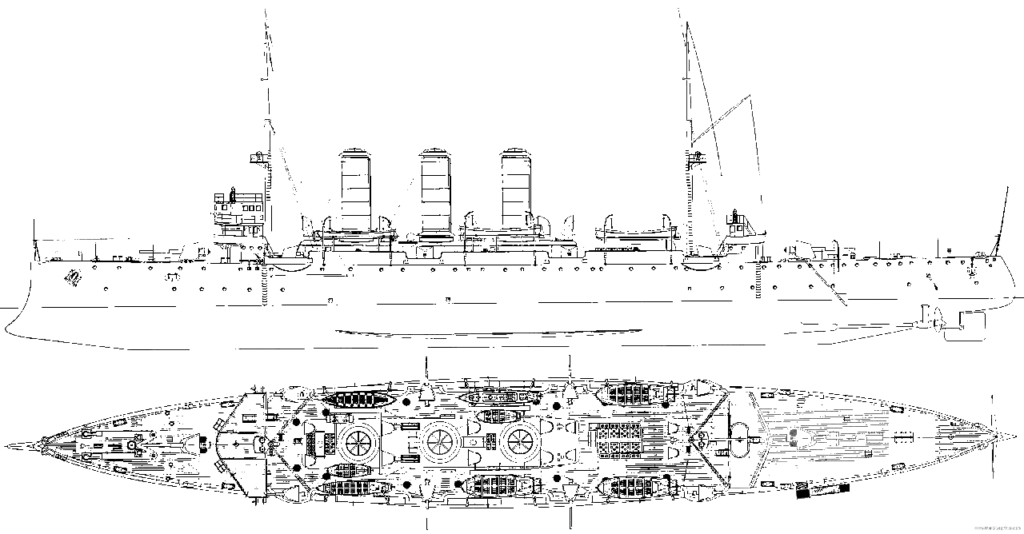
Hull and general design
Close to the Hamidiye originally, this protected cruiser was inspired by the British design of the Ottoman cruiser. This was not new to the Regia Marina which already ordered cruisers in Britain in the past. She measured 103.6 meters (339 ft 11 in) at the waterline but 111.8 m (366 ft 10 in) overall for a beam of 14.5 m (47 ft 7 in), draft of 5.5 m (18 ft 1 in). Displacement was 3,760 long tons (3,820 t) in normal load, 4,466 long tons (4,538 t) fully loaded and combat ready. Her silhouette was typical of cruisers of the time, symmetrical, with two pole masts, inverted bow, rounded, pointed stern, and flush deck. There was no straight section, the hull lines were fine and elliptical all along.
The superstructures were limited to a tall conning tower forward over which was mounted the bridge, smaller secondary conning tower aft of the mainmast with another structure. There was a long walkway elong the three equal round capped funnels heavenly spaced amidships and 12 air intakes. She carried 9 service boats of various siees and roles, placed on davits or supports.
The Libia's crew numbered 14 officers and 300 enlisted men. Colors-wise, she was apparently painted overall grey in the context of the Italo-Turkish war, and kept this livery as WW1 broke out and afterwards.
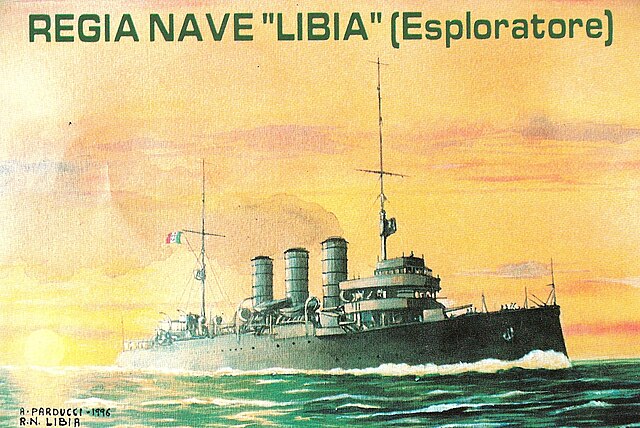
Armour protection layout
As a protected cruiser, it was limited to her armoured deck, creating a semi-belt by sloping downards on either side, in the turtleback fashion. The deck was 100 mm (4 in) thick on the slopes downward but thinner on the flat section. The forward conning had walls of 100 mm also, unknown for the aft conning tower. Main guns were protected by 76 mm (3 in) thick gun shields.
Powerplant
Libia was had two vertical triple-expansion steam engines (VTE) connected each to a 3-bladed propeller. Steam came from sixteen coal-fired Niclausse water-tube boilers, trunked into three closely spaced funnels on the centerline. Engines global powerplant were rated 12,500 indicated horsepower (9,300 kW). However in practice they were lower at 11,530 ihp (8,600 kW) and this was just enough for the contracted 22.9 knots (42.4 km/h; 26.4 mph) top speed. Range was 3,150 nautical miles (5,830 km; 3,620 mi) at 10 knots (19 km/h; 12 mph), well enough for the Mediterranean.
Armament
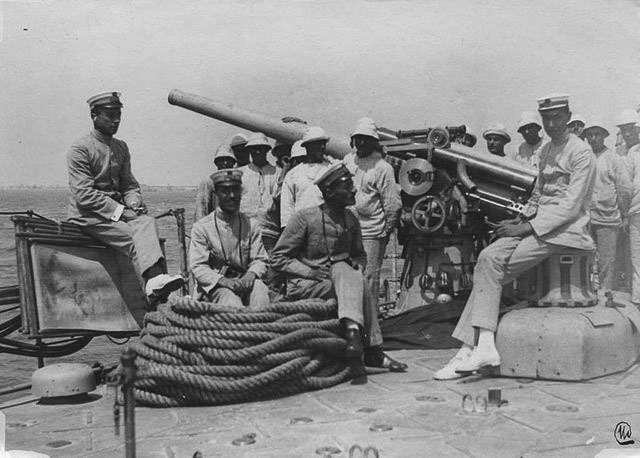
Relatively light as a cruiser she carried only two main guns, 6-inches in caliber, 152mm/50 A1913 models from Vickers on deck fore and aft, completed by eight single 120mm/45 A1913 guns along the sides and eight single 47mm/50 V1908 and six rapid fire 37mm/25 H1890 to deal with torpedo boats. It was rounded up by two 450mm torpedo tubes in the beam, above water.
Main
The type is unknown, lilely Ansaldo. Some historians even came from suggestions, including Skoda 50 caliber guns. The most common is that these L/50 6-inches quick-firing guns on individual pivot mounts, were Pattern FF Armstrong guns, firing a 20-kilogram (44 lb) shell at 780 meters per second (2,600 ft/s).
They were removed in 1925.
Secondary
The secondary battery of eight 120 mm (4.7 in) L/45 guns, four mounted individually on each broadside, including four further after and forward on sponsons. "A1913" is foggy, ans since Italian guns were 40 calibers for that era, the only possibility is the QF 4.7 in Mark III 45 cal. firing at 9,600 yards (8,800 m).
Light Artillery
Armament was rounded for anti-torpedo defence with eight 47mm/50 Vickers model 1908, a variant of the QF 3-pounder Hotchkiss already well treated on previous articles.
It was completed by six rapid fire 37mm/25 Hotchkiss model 1890. These were five-barreled revolving autocannons working with gravity clips like the Gatling gun. Short-range, for dealing with personal only. It is not precised if they were dismountable to be fitted on wheeled undercarriages and support landing parties.
Later in 1917-18, she saw the installation of two or three Ansaldo 76 mm L/40 anti-aircraft guns.
Torpedo Tubes
Given the only openings shown on the hull, these 450 mm (17.7 in) Whitehead models torpedo tubes were located just abaft the first and second funnel above the waterline and sloped armoured deck, under small folding hatches.
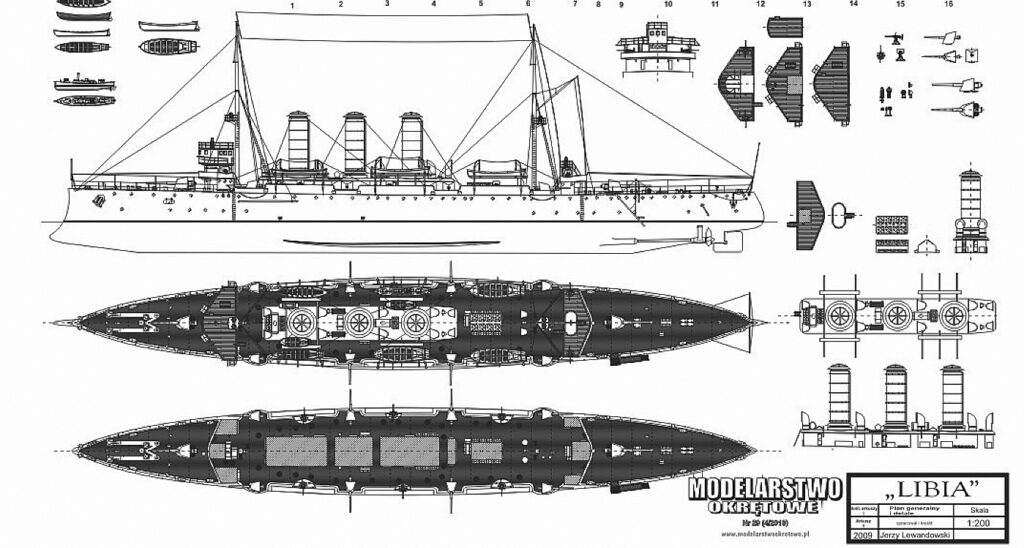
⚙ specifications as built |
| Displacement | 3,760 long tons (3,820 t) standard, 4,466 long tons (4,538 t) fully loaded |
| Dimensions | 111.8 x 14.5 x 5.5m (366 ft 10 in x 47 ft 7 in x 18 ft 1 in) |
| Propulsion | 2 shafts VTE, 16 × Niclausse boilers 11,530 ihp (8,600 kW) |
| Speed | 22.9 knots (42.4 km/h; 26.4 mph) |
| Range | 3,150 nmi (5,830 km; 3,620 mi) at 10 knots (19 km/h; 12 mph) |
| Armament | 2× 152, 8× 120, 8× 47, 6× 37 mm guns, 4× 450 mm TTs |
| Protection | Deck 100, CT 100 (4.5 in), Gun shields 76 mm (3 in) |
| Crew | 14 officers, 300 enlisted men |
Read More/Src
Books
Brescia, Maurizio; de Toro, Augusto (2022). Italian Heavy Cruisers: From Trento to Bolzano. Barnsley: Seaforth
Cresciani, Gianfranco (2003). The Italians in Australia. Cambridge: Cambridge University Press..
Dodson, Aidan; Cant, Serena (2020). Spoils of War: The Fate of Enemy Fleets after the Two World Wars. Barnsley: Seaforth
"Exit Albania? Departure of Prince William of Wied—After the Revolution of July, 1914". New York Times Co.
Fraccaroli, Aldo (1985). "Italy". Conway's All the World's Fighting Ships 1906–1921.
Friedman, Norman (2011). Naval Weapons of World War One. NIP
Halpern, Paul G. (1987). The Naval War in the Mediterranean. NIP
Henderson, W. H., ed. (1919). "Four Months in the Adriatic". Naval Review.
Hurd, Archibald (1918). Italian Sea-power and the Great War. London: Constable & Company.
"Italian Cruiser Libia". The Marine Review. New York: Penton Pub. Co. 43 (2): 67. February 1913.
"Japanese Warships' Tour". The Pioneer Mail and Indian Weekly News. Vol. XLIX, no. 50. 1922.
Marinelli, Maurizio & Andornino, Giovanni (2013). Italy's Encounters with Modern China: Imperial Dreams, Strategic Ambitions. Palgrave Macmillan.
Noppen, Ryan K. (2016). Austro-Hungarian Cruisers and Destroyers 1914-18. New Vanguard. Vol. 241. Osprey Publishing.
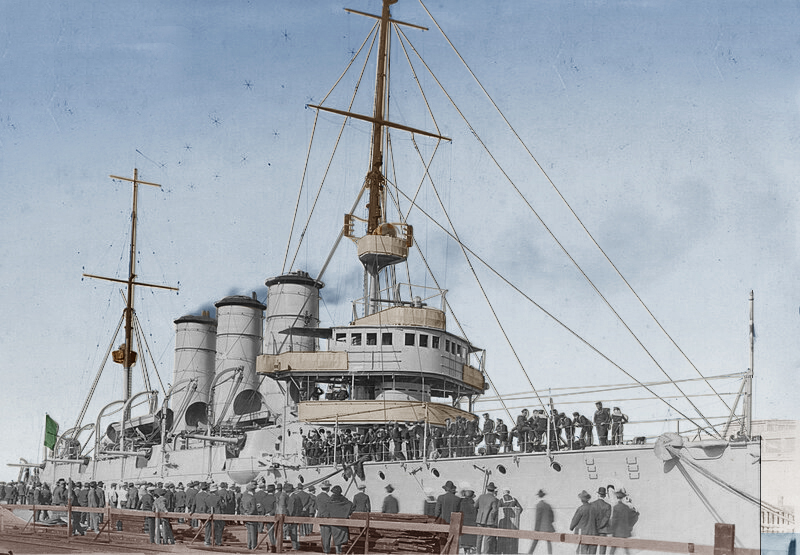
Links
trentoincina.it/
en.wikipedia.org/ Italian_cruiser_Libia
it.wikipedia.org
marina.difesa.it libia.aspx
on navypedia.org/
omnia.ie
on agenziabozzo.it/
marina.difesa.it
on patrimonio.archivioluce.com
worldnavalships.com
prints.rmg.co.uk/
Career of RN Libia 1912-1937
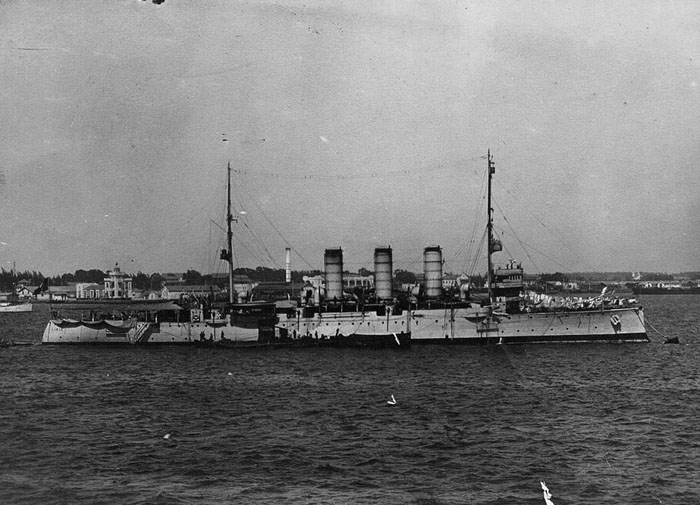
Laid down in 1907 at Ansaldo, Genoa for the Ottoman Empire as Drama, the rise of the Young Turks saw the Ottoman government suddenly endebted and Ansaldo halted all construction work. By late 1911 when Italy declared war on the Ottoman Empire, she was forcibly requisitioned, and the yard was paid to complet work on the same specifications. Launched on 11 November 1912, fitting-out work proceeded until she was commissioned on 25 March 1913 as Libia, at the time the most prized colony of the new Italian Empire. She had some time for training, including fleet training for the remainder of her prewar service (she missed the Italo-Urkish war).
On 3 September 1914, she was sent to Durazzo in Albania to evacuate Prince William following an insurgency, after the start of WWI. Libia landed also marines to restore order in Durazzo and evacuate some 2,000 refugees fleeing the insurgents, including many Italian residents, trying to catch passenger ships for Italy. They were were evacuated, Libia recalled the marines and departed for home.
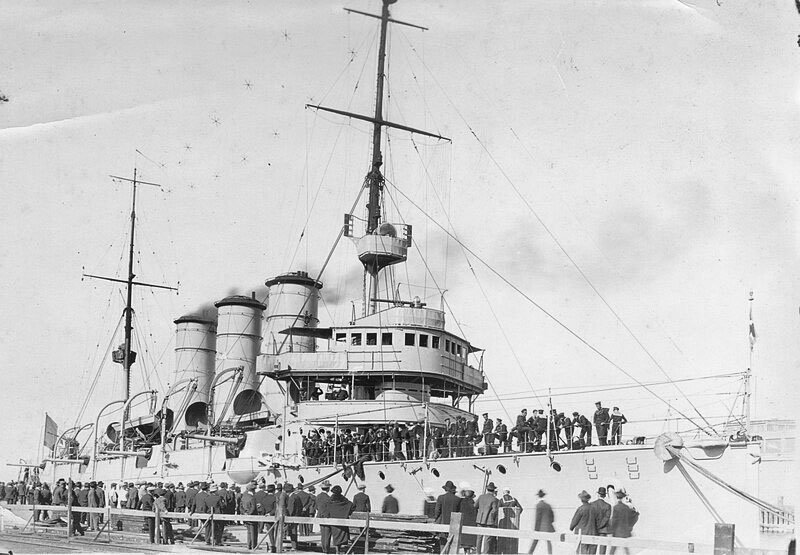 Libia during a port visit in Italy, private archive of Burzaghi admiral family, now CC
Libia during a port visit in Italy, private archive of Burzaghi admiral family, now CC
Neutrality was maintained until May 1915, after which Italy joined the Triple Entente and under Admiral Paolo Thaon di Revel the fleet was tasked to counter the Austro-Hungarian Navy, however the Adriatic was proven a deadly trap due to submarines and naval mines so the fleet action were soon confined to a blockade. Only MAS boats would raid the coast. Libia was thus relocated at Brindisi, southern Italy to patrol along the Otranto Barrage in the same division as the cruiser Puglia, Quarto, and Nino Bixio, destroyers and submarines. They soon wer reinforced by the British Adriatic Squadron (HMS Weymouth, Bristol, Topaze, Sapphire) and british one (Two French armored cruisers, 12 destroyers). All together, they patrolled along the line of minefields setup on this long line at sea.
Libia already saw action by May 1915, during the Austrian attack on Ancona, 23-24 May. One the morning of 24 May she was patrolling closely with the merchant cruiser SS Cittá di Siracusa, spotted and engaged the Austro-Hungarian scout cruiser
SMS Helgoland escorted by Tátra and Csepel. They duelled between 07:10 and 07:19, Libia managing to hit Helgoland once, but the faster Austro-Hungarians left them behind.
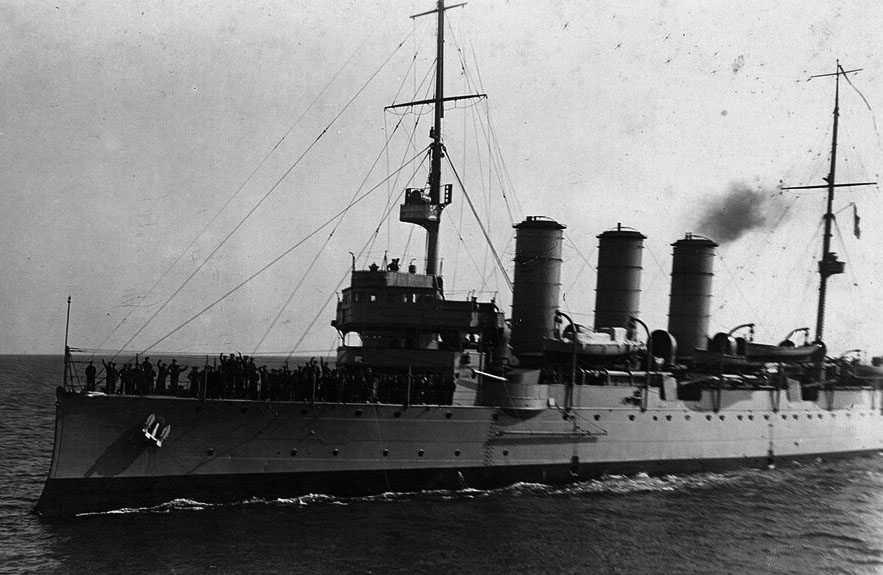 Libia underway, private archive of Burzaghi admiral family, now CC
Libia underway, private archive of Burzaghi admiral family, now CC
In early 1916, Libia was present at the last
battle of Durrazo, engaged in delaying shore bombardment before the city was taken. On 25 February, she entered the harbor for closer fire, protecting the evacuation of Allied transport vessels, and soon joined by the protected cruiser Puglia, and AMCs Cittá di Siracusa and SS Cittá di Catania. Austro-Hungarian artillery batteries soon targeted them in turn and they fuelled through the following day until evacuation was complete on the 26, both with Italian and Serbian troops sent to Valona.
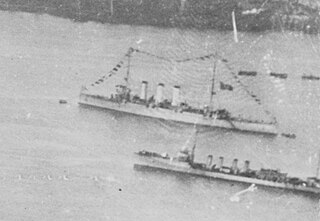
In September 1916, the cruiser was in the Bay of Salamis after Greek government refused to oppose Central Powers occupation of Eastern Macedonia. The entente seized the Greek fleet in what was called the "Noemvriana". Back home, Libia was modernized, with the fitting of two or three Ansaldo 76 mm L/40 anti-aircraft guns.
Nothing happened of significance in 1917-18. After November, Libia traveled to Britain and was present for the surrender of German U-boats at Harwich with sailors attributed ten U-boats as war preparation for Italy and bring back them home. In March 1919, Libia would return to Britain, in the Thames and London, a first for any Italian ships. She was visited by the government and citizesn alike for several days while the captain was invited to speak at the Royal United Services Institute.
 San Giorgio seen from Libia in 1923, provate photo by Admiral Ernesto Burzaghi, now CC
San Giorgio seen from Libia in 1923, provate photo by Admiral Ernesto Burzaghi, now CC
In 1921 she started a world tour as Italian good will ambassador under Captain Ernesto Burzagli, and admiral before WW2. She exited the Mediterranea, stopped in the Azores, and crossed the Atlantic to the Panama Canal by late 1921, stopped in Balboa for minor repairs (drainage and water systems), reached the Pacifioc coast and headed for San Francisco in November, staying for a month in which she was filmed for a short documentary by Frank Capra (first public film). She departed on 4 December and by 1922, crossed the Pacific, with multiple port visits until reaching Australia and went on westwards until reaching Colombo in British Ceylon, meeting there three Japanese cruisers, with crews exchanges, games and regatta.
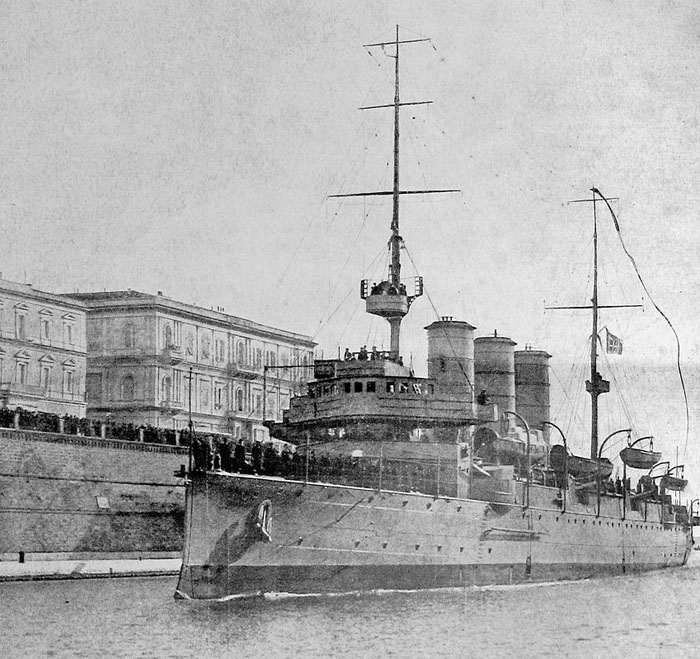 Libia back in Taranto, from "L'illustrazione Italiana" 18 March 1923
Libia back in Taranto, from "L'illustrazione Italiana" 18 March 1923
In 1925, she had her main guns removed as obsolete and to spare weight, and she sailed to take station in China, with the armored cruisers
San Marco and San Giorgio, river gunboats Caboto and Carlotto, forming the
Battaglione Italiano in China. Contingents from Libia were used as land parties to guard Italian consulates in Beijing and Shanhaiguan during troubles of the civil war.
On 28 March 1929, Libia collided with the Chinese coastal steamer SS Kangtai while off Woosung and the later sank with 30 boatd but damage on Libia was low, she was quickly repaired and remained in China until 1931. By the time, the Italian flotilla was reduced to her and the gunboats. But with the 1931 Mukden Incident and invasion of Manchuria, the brand new
heavy cruiser Trento was sent there by February 1932 and eventually Libia was replaced by the protected cruiser Quarto and went home. By September 1935 she was drydocked, then left in reserve and decommissioned/stricken from register the same day on 11 March 1937, sold for BU.


 Relatively light as a cruiser she carried only two main guns, 6-inches in caliber, 152mm/50 A1913 models from Vickers on deck fore and aft, completed by eight single 120mm/45 A1913 guns along the sides and eight single 47mm/50 V1908 and six rapid fire 37mm/25 H1890 to deal with torpedo boats. It was rounded up by two 450mm torpedo tubes in the beam, above water.
Relatively light as a cruiser she carried only two main guns, 6-inches in caliber, 152mm/50 A1913 models from Vickers on deck fore and aft, completed by eight single 120mm/45 A1913 guns along the sides and eight single 47mm/50 V1908 and six rapid fire 37mm/25 H1890 to deal with torpedo boats. It was rounded up by two 450mm torpedo tubes in the beam, above water.



 Laid down in 1907 at Ansaldo, Genoa for the Ottoman Empire as Drama, the rise of the Young Turks saw the Ottoman government suddenly endebted and Ansaldo halted all construction work. By late 1911 when Italy declared war on the Ottoman Empire, she was forcibly requisitioned, and the yard was paid to complet work on the same specifications. Launched on 11 November 1912, fitting-out work proceeded until she was commissioned on 25 March 1913 as Libia, at the time the most prized colony of the new Italian Empire. She had some time for training, including fleet training for the remainder of her prewar service (she missed the Italo-Urkish war).
On 3 September 1914, she was sent to Durazzo in Albania to evacuate Prince William following an insurgency, after the start of WWI. Libia landed also marines to restore order in Durazzo and evacuate some 2,000 refugees fleeing the insurgents, including many Italian residents, trying to catch passenger ships for Italy. They were were evacuated, Libia recalled the marines and departed for home.
Laid down in 1907 at Ansaldo, Genoa for the Ottoman Empire as Drama, the rise of the Young Turks saw the Ottoman government suddenly endebted and Ansaldo halted all construction work. By late 1911 when Italy declared war on the Ottoman Empire, she was forcibly requisitioned, and the yard was paid to complet work on the same specifications. Launched on 11 November 1912, fitting-out work proceeded until she was commissioned on 25 March 1913 as Libia, at the time the most prized colony of the new Italian Empire. She had some time for training, including fleet training for the remainder of her prewar service (she missed the Italo-Urkish war).
On 3 September 1914, she was sent to Durazzo in Albania to evacuate Prince William following an insurgency, after the start of WWI. Libia landed also marines to restore order in Durazzo and evacuate some 2,000 refugees fleeing the insurgents, including many Italian residents, trying to catch passenger ships for Italy. They were were evacuated, Libia recalled the marines and departed for home.
 Libia during a port visit in Italy, private archive of Burzaghi admiral family, now CC
Neutrality was maintained until May 1915, after which Italy joined the Triple Entente and under Admiral Paolo Thaon di Revel the fleet was tasked to counter the Austro-Hungarian Navy, however the Adriatic was proven a deadly trap due to submarines and naval mines so the fleet action were soon confined to a blockade. Only MAS boats would raid the coast. Libia was thus relocated at Brindisi, southern Italy to patrol along the Otranto Barrage in the same division as the cruiser Puglia, Quarto, and Nino Bixio, destroyers and submarines. They soon wer reinforced by the British Adriatic Squadron (HMS Weymouth, Bristol, Topaze, Sapphire) and british one (Two French armored cruisers, 12 destroyers). All together, they patrolled along the line of minefields setup on this long line at sea.
Libia already saw action by May 1915, during the Austrian attack on Ancona, 23-24 May. One the morning of 24 May she was patrolling closely with the merchant cruiser SS Cittá di Siracusa, spotted and engaged the Austro-Hungarian scout cruiser
Libia during a port visit in Italy, private archive of Burzaghi admiral family, now CC
Neutrality was maintained until May 1915, after which Italy joined the Triple Entente and under Admiral Paolo Thaon di Revel the fleet was tasked to counter the Austro-Hungarian Navy, however the Adriatic was proven a deadly trap due to submarines and naval mines so the fleet action were soon confined to a blockade. Only MAS boats would raid the coast. Libia was thus relocated at Brindisi, southern Italy to patrol along the Otranto Barrage in the same division as the cruiser Puglia, Quarto, and Nino Bixio, destroyers and submarines. They soon wer reinforced by the British Adriatic Squadron (HMS Weymouth, Bristol, Topaze, Sapphire) and british one (Two French armored cruisers, 12 destroyers). All together, they patrolled along the line of minefields setup on this long line at sea.
Libia already saw action by May 1915, during the Austrian attack on Ancona, 23-24 May. One the morning of 24 May she was patrolling closely with the merchant cruiser SS Cittá di Siracusa, spotted and engaged the Austro-Hungarian scout cruiser  Libia underway, private archive of Burzaghi admiral family, now CC
In early 1916, Libia was present at the last battle of Durrazo, engaged in delaying shore bombardment before the city was taken. On 25 February, she entered the harbor for closer fire, protecting the evacuation of Allied transport vessels, and soon joined by the protected cruiser Puglia, and AMCs Cittá di Siracusa and SS Cittá di Catania. Austro-Hungarian artillery batteries soon targeted them in turn and they fuelled through the following day until evacuation was complete on the 26, both with Italian and Serbian troops sent to Valona.
Libia underway, private archive of Burzaghi admiral family, now CC
In early 1916, Libia was present at the last battle of Durrazo, engaged in delaying shore bombardment before the city was taken. On 25 February, she entered the harbor for closer fire, protecting the evacuation of Allied transport vessels, and soon joined by the protected cruiser Puglia, and AMCs Cittá di Siracusa and SS Cittá di Catania. Austro-Hungarian artillery batteries soon targeted them in turn and they fuelled through the following day until evacuation was complete on the 26, both with Italian and Serbian troops sent to Valona.
 In September 1916, the cruiser was in the Bay of Salamis after Greek government refused to oppose Central Powers occupation of Eastern Macedonia. The entente seized the Greek fleet in what was called the "Noemvriana". Back home, Libia was modernized, with the fitting of two or three Ansaldo 76 mm L/40 anti-aircraft guns.
Nothing happened of significance in 1917-18. After November, Libia traveled to Britain and was present for the surrender of German U-boats at Harwich with sailors attributed ten U-boats as war preparation for Italy and bring back them home. In March 1919, Libia would return to Britain, in the Thames and London, a first for any Italian ships. She was visited by the government and citizesn alike for several days while the captain was invited to speak at the Royal United Services Institute.
In September 1916, the cruiser was in the Bay of Salamis after Greek government refused to oppose Central Powers occupation of Eastern Macedonia. The entente seized the Greek fleet in what was called the "Noemvriana". Back home, Libia was modernized, with the fitting of two or three Ansaldo 76 mm L/40 anti-aircraft guns.
Nothing happened of significance in 1917-18. After November, Libia traveled to Britain and was present for the surrender of German U-boats at Harwich with sailors attributed ten U-boats as war preparation for Italy and bring back them home. In March 1919, Libia would return to Britain, in the Thames and London, a first for any Italian ships. She was visited by the government and citizesn alike for several days while the captain was invited to speak at the Royal United Services Institute.
 San Giorgio seen from Libia in 1923, provate photo by Admiral Ernesto Burzaghi, now CC
In 1921 she started a world tour as Italian good will ambassador under Captain Ernesto Burzagli, and admiral before WW2. She exited the Mediterranea, stopped in the Azores, and crossed the Atlantic to the Panama Canal by late 1921, stopped in Balboa for minor repairs (drainage and water systems), reached the Pacifioc coast and headed for San Francisco in November, staying for a month in which she was filmed for a short documentary by Frank Capra (first public film). She departed on 4 December and by 1922, crossed the Pacific, with multiple port visits until reaching Australia and went on westwards until reaching Colombo in British Ceylon, meeting there three Japanese cruisers, with crews exchanges, games and regatta.
San Giorgio seen from Libia in 1923, provate photo by Admiral Ernesto Burzaghi, now CC
In 1921 she started a world tour as Italian good will ambassador under Captain Ernesto Burzagli, and admiral before WW2. She exited the Mediterranea, stopped in the Azores, and crossed the Atlantic to the Panama Canal by late 1921, stopped in Balboa for minor repairs (drainage and water systems), reached the Pacifioc coast and headed for San Francisco in November, staying for a month in which she was filmed for a short documentary by Frank Capra (first public film). She departed on 4 December and by 1922, crossed the Pacific, with multiple port visits until reaching Australia and went on westwards until reaching Colombo in British Ceylon, meeting there three Japanese cruisers, with crews exchanges, games and regatta.
 Libia back in Taranto, from "L'illustrazione Italiana" 18 March 1923
In 1925, she had her main guns removed as obsolete and to spare weight, and she sailed to take station in China, with the armored cruisers
Libia back in Taranto, from "L'illustrazione Italiana" 18 March 1923
In 1925, she had her main guns removed as obsolete and to spare weight, and she sailed to take station in China, with the armored cruisers